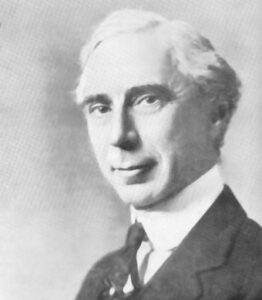Science Seen Physicist and Time One author Colin Gillespie helps you understand your world.
No Number is Very Large
This week we venture into mathematical philosophy to shine a light on some long-standing mind benders that maybe we can now resolve. And they turn out to be profoundly practical.
Does infinity exist or is it a figment of imagination? Are numbers a property of the universe that we discover or are they ideas we invent? Philosophers and mathematicians have long wrestled with these and other such deep issues. They wrestle in earnest. Immeasurable consequences in the realm of physics—which is based on math—hinge upon the answers, yet so far the answers are not clear.
Famed British philosopher and mathematician Bertrand Russell did more than his share of the wrestling. In 1900, at the watershed of his career he wrote to his wife, ‘I am just beginning to get a glimmering of the nature of numbers’. This was no false modesty. He hoped to listen to some lectures so he could ‘get to know something about the number one’, a number that had great significance for him because he could construct all other numbers from it. He went on to tell his wife:
‘I can now prove that no number is very large. For 1 is certainly not so, and if any number you like to take is not very large no more is the next one after it: and so no number is very large because they can never begin being so.’
This is a variation of the sorites paradox known to the ancient Greeks. Russell’s version is now known as Wang’s Paradox, named for American philosopher, logician and mathematician Hao Wang, who was born two decades later and who merely mentioned it. Go figure!
named for American philosopher, logician and mathematician Hao Wang, who was born two decades later and who merely mentioned it. Go figure!
Russell’s little mind game is directed to some of those deep issues. His philosophy was realist. That is, he saw math (and by extension physics) as being about objects that actually exist. His math allowed infinities; in his day the universe was usually assumed to be infinite.
Modern cosmology gnaws at the foundations of this assumption. My book, Time One: Discover How the Universe Began, says that—as Russell thought—the universe is made of just one kind of thing (quanta of space called flecks). In the beginning there was only one of them. Fleck replication (by quantum tunneling) created the world we know and love. In the process this gives real substance to the natural numbers that formed the foundation of several of Russell’s works. Particle physicist and topologist Sundance Bilson-Thompson revealed the key to how the matter that we see comes from twists in links between flecks (he calls them ribbons). It’s an elegant picture that shows us where both real math and laws of physics come from.
What does it add to that long history of wrestling? Well, many cosmological measurements tell us that those space quanta have been replicating for a long but finite time (less than fourteen billion years). Ipso facto then, the universe, though vast must also be finite. Indeed the number of those incredibly small quanta of space that exist at any instant, though almost inconceivable, can be written on a single page. For Russell the realist, this would mean there are no infinities in math, except of course in what we could call math fiction.
This leads to another simple insight. The first theorem of number theory says: There is no largest natural number. (Do we hear echoes of Wang’s Paradox?) But we now see that it is wrong. The classic proof of the theorem is to assume there is a largest natural number, call it N. So what is N+1? But note this proof contains a hidden assumption: that there is another one to add to N. Should we simply accept this assumption? If he had had the opportunity to view the universe as made up of a finite number of things, Russell (like another famous realist logician, Kurt Gödel) would undoubtedly have answered: No. So much for the foundations of number theory.
Thus there is a need to distinguish real math from math fiction. The latter can be entertaining, even useful, but it is not grounded in the world. Making this distinction sets the stage for humanity’s next great mind-adventure: real physics!
Sources:
Bertrand Russell (1900), October 29 letter to Alys Pearsall Smith, reproduced in The Selected Letters of Bertrand Russell, vol. 1, The Private Years (1884 – 1914), ed. Nicholas Griffin (1992), Boston: Houghton Mifflin Company, p. 204.
Sundance Bilson-Thompson (2008), “A topological model of composite preons”, Cornell University Library, http://arxiv.org/abs/hep-ph/0503213
Image source: http://www.lehman.cuny.edu/deanhum/philosophy/BRSQ/04feb/cover.htm

Tap Settings.